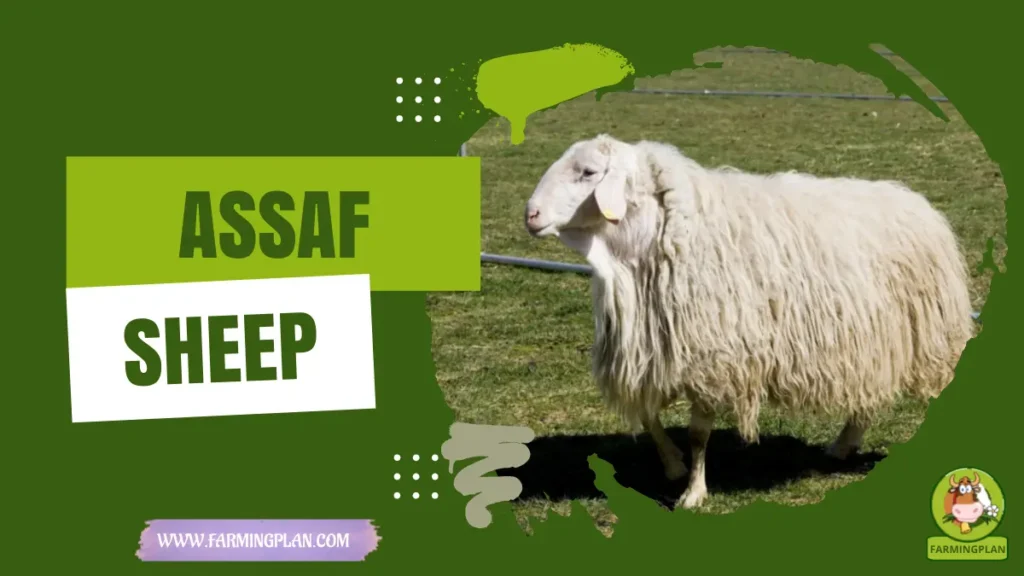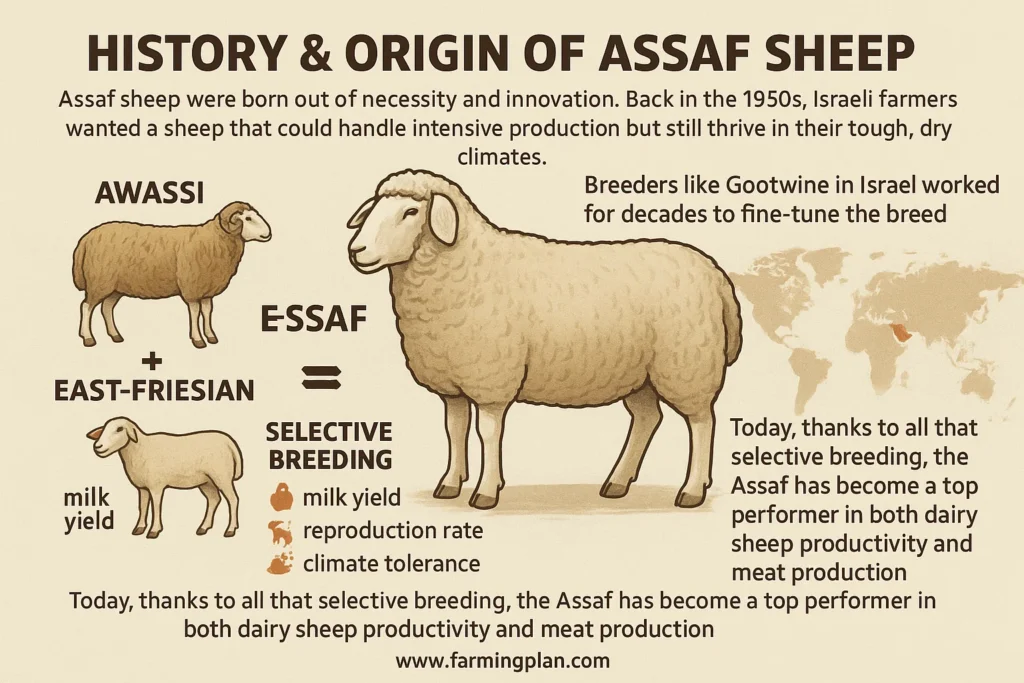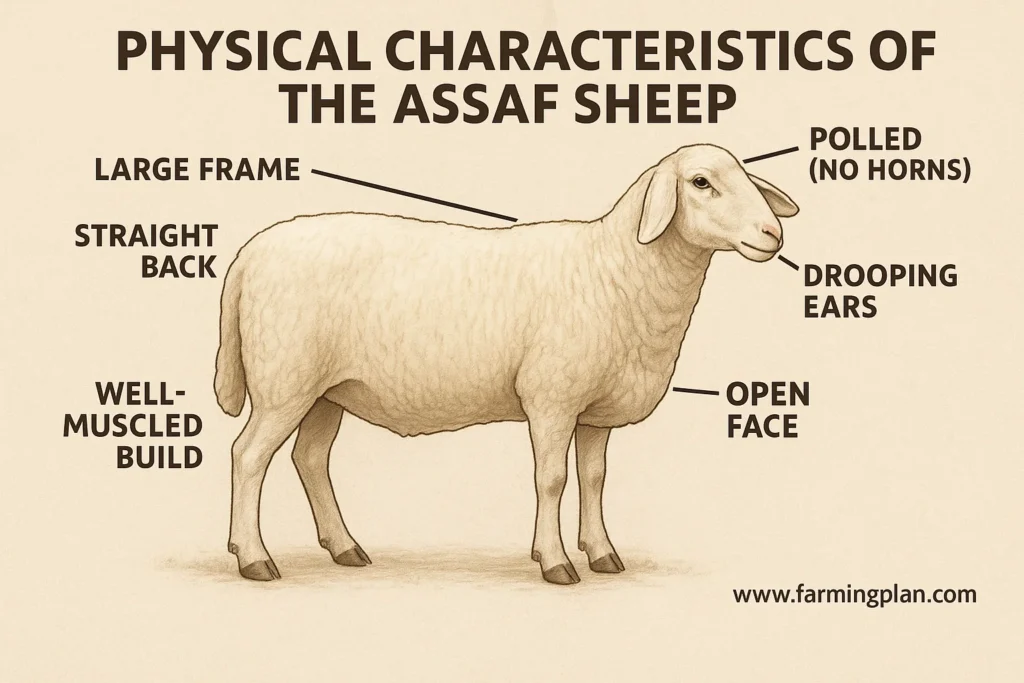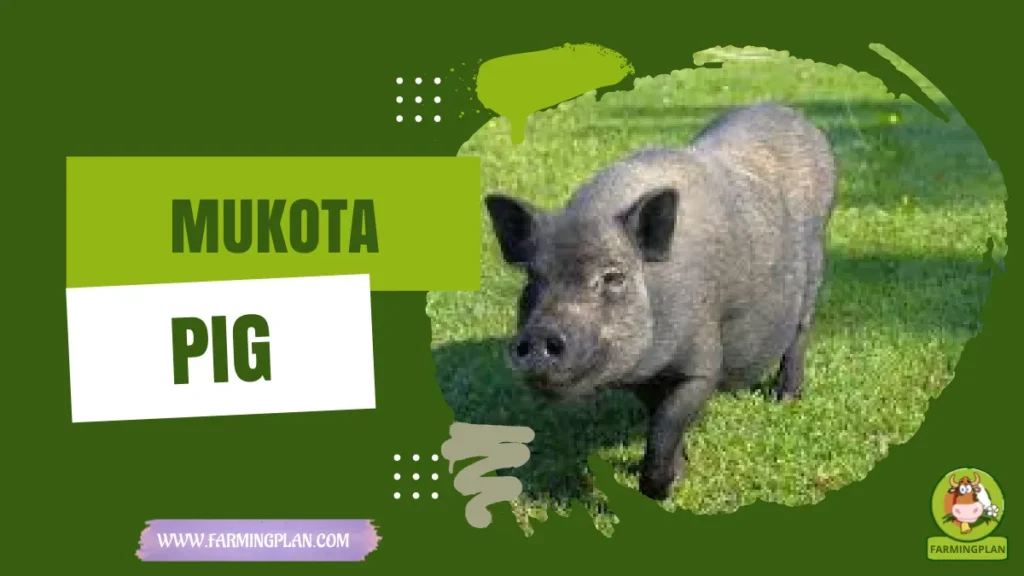Let me tell you about one of the hardest-working breeds on my farm—the Assaf sheep. These strong, sturdy animals were developed in Israel to excel in both milk and meat production—and they do just that. With high milk yields, strong lambing rates, and calm temperaments, they’ve become a staple in my flock. Whether you’re a new sheep owner or managing a large farm, Assaf sheep are a smart, productive choice. But keep in mind, they do need careful management and daily attention. In this article, I’ll share everything I’ve learned—from their origins to hands-on care. Let’s dive in!

History & Origin of Assaf Sheep
Assaf sheep were born out of necessity and innovation. Back in the 1950s, Israeli farmers wanted a sheep that could handle intensive production but still thrive in their tough, dry climates. So, what did they do? They crossed two champions: the Awassi, known for rich milk, and the East-Friesian, famous for high yields. The result? A powerhouse hybrid that took the best of both worlds.

The Assaf wasn’t just a fluke. Breeders like Gootwine in Israel worked for decades to fine-tune the breed. They looked at traits like milk yield, reproduction rate, and climate tolerance. Today, thanks to all that selective breeding, the Assaf has become a top performer in both dairy sheep productivity and meat production. Its adaptability to various climates and its spread far beyond Israel into Europe, the Americas, and anywhere farmers want sheep that work smart and hard, make it a confident choice for any farmer.
Read More: Southdown Sheep: Smallest British Breed
Physical Characteristics of the Assaf Sheep
When you first see an Assaf sheep, you’ll notice how big and solid they look. These aren’t dainty animals. They’ve got large frames, straight backs, and a well-muscled build. Their wool is typically white, though the fleece isn’t really the star of the show—it’s their milk and meat performance that steal the spotlight.

Their faces are open, without heavy wool covering their eyes, which makes them easier to manage during lambing or milking. Both ewes and rams are polled (no horns), and their ears droop slightly, giving them a calm, curious look. They’re not show animals, but boy, do they get the job done.
Read More: Arabi Sheep: How To Start Your Farm
Temperament & Behavior of Assaf Sheep
If you’re new to sheep farming, you’ll love how easy Assaf sheep are to work with. They’re naturally calm, and they adapt well to being around people. I’ve found that even when I’m walking through the paddock during lambing season, they rarely spook or act skittish.

Assaf ewes are excellent mothers. They bond quickly with their lambs and usually have multiple lambings per year, which is a huge plus if you’re building up your flock. They do great in group housing, especially in intensive systems, and their strong social behavior means they handle flock life well. Their low maintenance and strong social behavior mean that if you treat them with respect and give them consistent care, they’ll reward you with steady milk, healthy lambs, and fewer headaches.
Read More: Afghan Arabi Sheep: Strong, Hardy & Valuable
Food & Diet
Feeding Assaf sheep right is key to keeping their milk production at top levels. On my farm, I stick to a balanced diet of hay, grains (such as barley or oats), and fresh greens (like clover or alfalfa), depending on the season. I always make sure they’ve got free access to clean water, especially during peak lactation periods.
During lactation, I boost their diet with extra protein—think alfalfa or a grain mix with soy meal. This helps them maintain body condition while still pouring out the liters. Salt and mineral blocks are non-negotiable in my barn. Without those, you’ll start seeing a drop in milk yield or even health issues. Avoid feeding moldy or fermented feed. Trust me—nothing will wreck your ewe’s health faster than bad hay or poor-quality grain.
Usage & Purpose of the Assaf Sheep
The Assaf sheep really shines as a dual-purpose breed. On the dairy side, these ewes regularly produce over 500 liters of milk per lactation, and some even go higher with good feed and milking routines. Their milk is rich, too—perfect for cheese production. If you’ve never tasted cheese made from Assaf milk, you’re missing out. They’re also solid meat producers. Their lambs grow quickly, and the meat is flavorful, lean, and popular in local markets. If you’re raising sheep for both meat and milk, this breed ticks all the boxes. The profitability of this breed is something to get excited about.
They’re also solid meat producers. Their lambs grow quickly, and the meat is flavorful, lean, and popular in local markets. If you’re raising sheep for both meat and milk, this breed ticks all the boxes. I use Assaf rams for breeding too—they pass on some solid genetics and help improve prolificacy in my mixed flocks.
Special Features that Set the Assaf Apart
Here’s what really sets the Assaf sheep apart: high lambing rates, incredible milk output, and hardy nature. These girls don’t mess around. They’ll often give birth to twins or triplets, and bounce back fast with proper care. That kind of reproductive performance is gold in any dairy setup.
They’re also built to handle a wide range of climates. Whether you’re in a temperate region or dealing with hot summers, they hold up well—thanks to their Awassi bloodline. Another thing I’ve noticed? They’re really responsive to genetic selection. If you track your flock and breed smart, you can get top-tier results within just a few generations. Selecting and breeding Assaf sheep is a crucial part of sheep farming. By choosing the right rams and ewes based on their genetic traits, you can improve the productivity and health of your flock.
Choose Smart, Farm Smarter—Assaf Sheep Turn Every Drop Of Effort Into Profitable Performance.
Common Health Issues & How I Prevent Them
Like any breed, Assaf sheep have their weak spots. The main things I keep an eye on are mastitis, parasites, and lameness. Because they produce a lot of milk, their udders need to be monitored closely—especially during lactation peaks. I clean teats before and after milking and use post-milking dips to prevent infection. Internal parasites can sneak up fast in intensive systems, so I rotate pastures and follow a strict deworming schedule. I also check their hooves every few weeks. A little trimming goes a long way to prevent foot rot and other hoof issues. And don’t skip vaccinations! Prevention is way cheaper—and easier—than treatment.
Step-by-Step Farming Guide for Raising Assaf Sheep
Raising Assaf sheep isn’t just rewarding—it’s downright exciting if you love dairy farming or quality meat production. These strong, productive animals thrive with good care and proper management. In this guide, I’ll walk you through each step I follow on my own farm to keep my Assaf flock healthy, happy, and highly productive. Whether you’re just starting out or looking to fine-tune your system, these steps will give you a solid path forward.
Step 1: Choose Quality Breeding Stock
Start with healthy Assaf sheep for sale from reputable breeders. Look for animals with strong milk records, clean health history, and solid lambing performance. Avoid ones that look weak, have poor body condition, or show signs of past mastitis. Ask for performance data if it’s available. Some of the best farms keep track of things like liters per lactation, lambs per lambing, and genetic background. Trust me—it’s worth the extra research.
Step 2: Set Up Proper Housing
A good barn makes all the difference. Your Assaf sheep need shelter from rain, wind, and heat. I use open-sided barns with clean bedding, proper ventilation, and enough space so they’re not overcrowded. Keep lambing pens separate and quiet. Ewes need privacy during birth and space to bond with their lambs. Clean bedding and low-stress space lead to healthier newborns and fewer problems after parturition.
Step 3: Create a Balanced Feeding Program
Feed is your biggest tool for boosting milk production. I mix up the diet depending on lactation stage. Right after lambing, I go heavier on protein and energy sources. Later, I switch to maintenance rations with plenty of fiber. Offer free-choice minerals and avoid sudden diet changes—they can upset their rumen and drop yields. Always have clean water available. You’d be amazed how much more they’ll produce with proper hydration.
Step 4: Monitor Health Closely
I do regular health checks every morning. Look at udders, check hooves, feel for bloating or heat stress. Keep an eye on milk quality, too. Any drop could mean infection or nutrition gaps. Vaccinate on schedule, follow up with deworming every few months, and isolate any sick animals quickly. Careful husbandry is your best insurance policy in any flock.
Step 5: Track Reproduction & Lambing Rates
This is where Assafs really shine. Keep records of lambings, birth rates, and prolificacy. I use a simple notebook and tag lambs at birth. It helps me select which ewes are top performers. During breeding season, I pair ewes with high-performing rams. Keep the photoperiod in mind—longer days can improve lambing results. With smart timing, you can get two lambings a year in some flocks.
Expert Tips & Best Practices from My Farm
One of the most helpful habits I’ve picked up is tracking milk yield week by week. It’s a small effort that pays off big—if you notice production dipping early, you can adjust feed or check for health issues before things get worse. In the milking area, I’ve installed rubber mats. Trust me, they’re a game-changer for preventing slips and reducing hoof stress, especially when the floor gets damp.
Come summertime, I like to treat my flock to fresh-cut greens. Not only does it boost their nutrition, but it actually improves the flavor of their milk—and by extension, the cheese. If you’re breeding your own flock, don’t forget to rotate your rams every few years. It keeps the genetics fresh and helps avoid any inbreeding problems. And one more big one—always quarantine new arrivals for at least two to three weeks. Even if they look perfectly healthy, it’s better to be safe than sorry. A little isolation now can prevent a major outbreak down the line.
FAQ
What is the Assaf sheep known for?
Assaf sheep are famous for their high milk yield and great meat quality. They’re ideal for dual-purpose farming systems.
How much milk does an Assaf sheep produce?
Most Assaf ewes produce between 450–550 liters per lactation, with some reaching over 600 liters under intensive management.
Are Assaf sheep easy to care for?
Yes! They’re calm, adaptable, and respond well to routine care—perfect for both new and experienced farmers.
What do Assaf lambs weigh at birth?
Lambs are usually born at around 3.5–4.5 kg, and they grow quickly if fed well and kept healthy.
Can Assaf sheep be raised in hot climates?
Absolutely. Their Awassi heritage gives them strong tolerance for heat and dry weather, making them great for varied environments.
Conclusion
If you’re looking for a sheep breed that can go the distance, the Assaf sheep is your best bet. With high milk yields, reliable lambing rates, and an easygoing nature, these sheep fit perfectly into modern farming systems. I’ve raised a lot of breeds, but few match the Assaf for sheer performance and profit. Whether you’re milking for cheese or raising lambs for market, this breed delivers results without the fuss. Give them the right care, and they’ll take your flock to the next level.


